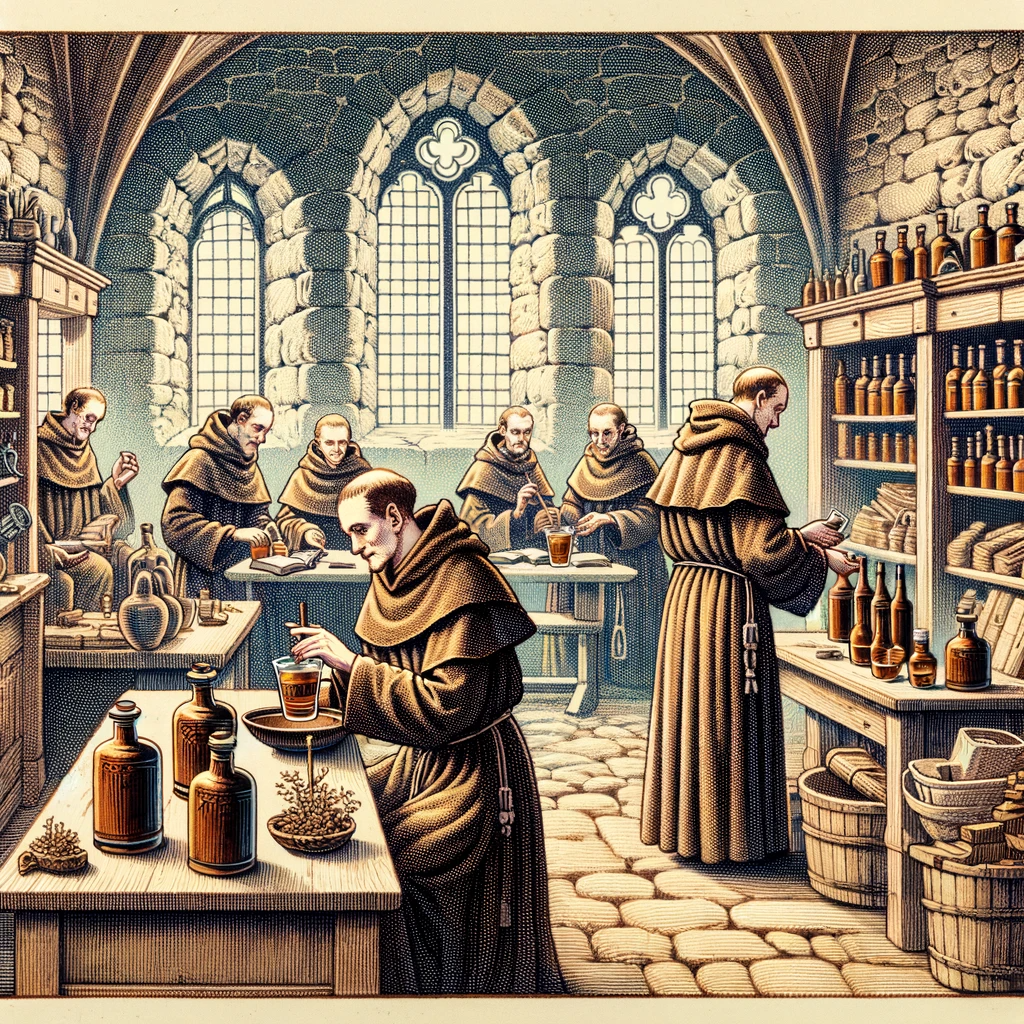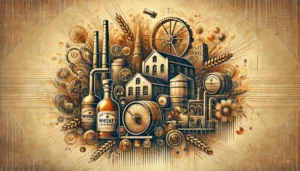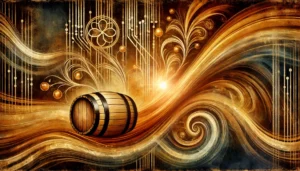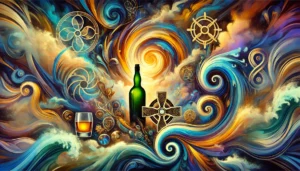Introduction to Irish Whiskey and Its Monastic Connection
Irish whiskey, renowned for its smooth texture and distinctive flavour, has a rich history deeply intertwined with the island’s monastic traditions. The story of Irish whiskey is not just one of distillation and aging; it’s a narrative steeped in spiritual endeavours, historical upheavals, and cultural evolution. In “Sacred Spirits: Unveiling the Monastic Roots of Irish Whiskey,” we embark on a journey to explore how the serene corridors of Irish monasteries laid the foundation for one of the world’s most beloved spirits.
The monastic influence on Irish whiskey dates back to the early medieval period. Monks, the learned scholars of their time, were instrumental in introducing distillation techniques to Ireland, having acquired knowledge during their travels to Mediterranean lands. These religious sanctuaries became the cradles of whiskey-making, where monks harnessed the art of transforming basic ingredients into elixirs of remarkable complexity. This sacred craft was not merely about creating a beverage; it was a divine pursuit, a blend of science and spirituality.
Irish monasteries, nestled in the lush, green landscapes, were more than religious centres; they were hubs of innovation and learning. The monks’ dedication to perfecting distillation techniques played a pivotal role in the evolution of Irish whiskey. Their expertise in harnessing local ingredients like barley and pure Irish water contributed to the unique character of the whiskey we cherish today. It was within these hallowed walls that whiskey transcended its role as a mere drink, intertwining with Ireland’s cultural and spiritual identity.
As we delve deeper into the monastic roots of Irish whiskey, we discover not just the origins of a spirit, but also the soul of a nation. From the ancient corridors of monastic distilleries to the sprawling modern whiskey enterprises, this exploration is a toast to the spiritual and historical legacy that continues to shape Irish whiskey.
History of Monastic Distillation Practices in Ireland
The story of Irish whiskey begins in the early medieval period, a time when Ireland’s monasteries were the bastions of learning and innovation. It was in these spiritual havens that the art of distillation, a technique originally developed for creating perfumes and medicinal concoctions, was first introduced to Ireland.

The Arrival of Distillation
Distillation techniques likely made their way to Irish shores via monks returning from their pilgrimages or studies in Mediterranean countries. These monastic scholars were quick to adapt and refine these methods, seeing the potential of distillation in transforming local ingredients into something extraordinary. The Irish term for whiskey, “uisce beatha,” meaning “water of life,” reflects the high regard in which this spirit was held.
Monastic Distilleries: The Early Pioneers
The monasteries, with their emphasis on study and experimentation, became the early distilleries of Ireland. Utilizing rudimentary stills, the monks began experimenting with fermenting and distilling local grains. The typical monastic still was basic, often made from copper or iron, and operated over open flames. These early distilleries were not just centres of whiskey production but also hubs of innovation and learning.
Whiskey: A Spiritual Elixir
For the monks, whiskey was more than a beverage; it was a potion with spiritual significance. It was used in religious rituals and as a medicinal remedy for a variety of ailments. The monasteries’ secluded settings, often in areas of natural beauty and tranquility, also contributed to the mystique and allure of the whiskey they produced.
Preservation of Whiskey Making Techniques
During the turbulent times of Viking invasions and later political upheavals, many monasteries were destroyed. However, the knowledge of whiskey making survived, largely thanks to the oral traditions and the monks’ meticulous documentation practices. These records would later serve as invaluable guides for the resurgence of whiskey production in Ireland.
The Legacy of Monastic Distillation
The legacy of monastic whiskey production is evident in the techniques still used in modern Irish whiskey distilleries. The emphasis on quality ingredients, the pursuit of purity in the distillation process, and the deep respect for the craft all hark back to the monastic traditions of old.
As we reflect on the monastic influence on Irish whiskey, it becomes clear that these early distillers were not just making a drink; they were crafting a legacy that would endure for centuries.
The Spiritual and Cultural Significance of Whiskey in Monastic Life
In the monasteries of medieval Ireland, whiskey was more than a distilled spirit; it was an integral part of the monks’ spiritual and daily life. This section delves into how whiskey found its place in the monastic tradition, not just as a beverage, but as a symbol of hospitality, a medicinal elixir, and a component of religious rituals.
Whiskey as a Medicinal Remedy
The monastic communities were known for their knowledge of herbal remedies and healing practices. Whiskey was often infused with herbs and was considered a potent medicine for various ailments. It was used both as an internal remedy and as an antiseptic for treating wounds. The monks’ understanding of herbs and their effects when combined with whiskey made these concoctions highly valued.
A Symbol of Hospitality and Community
Monasteries were often places of refuge and hospitality for travelers. Offering whiskey to guests was a sign of welcome and generosity. This tradition reinforced the communal spirit and the importance of sharing and caring for others, which were core values of monastic life.
Whiskey in Religious Ceremonies
Whiskey also had a role in religious observances. It was used in some monasteries during mass and other religious ceremonies, symbolizing the sacredness of their rituals. The use of whiskey in these contexts reflects its perceived purity and the spiritual significance it held in monastic culture.
The Cultural Impact
The production and use of whiskey in monasteries had a lasting impact on Irish culture. It helped to cement the role of whiskey in Irish society, intertwining it with notions of hospitality, community, and spiritual well-being. The cultural practices surrounding whiskey that originated in monasteries continue to influence how it is perceived and consumed in Ireland today.
Preserving Tradition through Oral Histories and Documentation
Despite the lack of extensive written records from this period, the traditions and knowledge of whiskey production in monasteries have been passed down through generations. Oral histories and later documentation have helped preserve the legacy of these early whiskey-making practices.
This section of the article explores the multifaceted role that whiskey played in monastic life, highlighting its significance beyond just being a beverage. It paints a picture of how monastic practices have shaped the cultural and spiritual dimensions of Irish whiskey.
Transition from Monastic to Commercial Whiskey Production
The evolution of Irish whiskey from its monastic origins to a commercial enterprise is a tale of adaptation, innovation, and survival. This section explores the pivotal shift from the tranquil cloisters of monasteries to the dynamic world of commercial distilleries, a transition that has significantly shaped the Irish whiskey industry.

The Decline of Monastic Distilleries
The dissolution of monasteries, particularly during the 16th and 17th centuries, marked a significant turning point. The turbulent political and religious climate of the time saw many monastic communities disbanded and their distilleries closed. This disruption led to the gradual decline of monastic whiskey production.
The Emergence of Commercial Distilleries
In the wake of the monastic decline, whiskey production began to emerge as a commercial enterprise. Entrepreneurs and former monks, leveraging the distilling knowledge they had acquired, started to establish private distilleries. These early commercial distilleries were often small and family-run, but they laid the groundwork for the industry’s future growth.
Technological Advancements and Expansion
The 18th and 19th centuries saw significant technological advancements in distillation. The introduction of the column still, alongside the traditional pot still, allowed for more efficient production and a wider variety of whiskey styles. This period also marked the expansion of the Irish whiskey industry, both domestically and internationally, as demand for the spirit grew.
Regulation and Standardization
With the growth of commercial distilleries, the need for regulation and standardization became evident. Laws were enacted to govern the production, quality, and sale of whiskey, helping to protect the integrity of the industry and its products. These regulations also played a role in distinguishing Irish whiskey from other whiskey styles around the world.
The Legacy of Monastic Whiskey in Modern Production
Despite the shift to commercial production, the legacy of monastic whiskey-making techniques and principles continued to influence the industry. Many modern distilleries still draw on the knowledge and practices developed by the monks, maintaining a connection to the spirit’s historical roots.
The transition from monastic to commercial production marks a significant chapter in the history of Irish whiskey. It highlights the resilience and adaptability of the spirit, evolving over time while retaining its connection to its ancient origins.
Legacy and Influence: Monastic Traditions in Modern Irish Whiskey Making
The final chapter in the story of Irish whiskey is a testament to the enduring legacy of its monastic roots. This section explores how contemporary Irish whiskey makers not only continue the tradition but also honour and preserve the ancient practices established by the monks centuries ago.

Respecting the Past, Embracing the Future
Modern Irish whiskey distilleries are a blend of tradition and innovation. While they employ cutting-edge technology for efficiency and consistency, many still adhere to the time-honoured techniques and principles of monastic distillation. The respect for quality ingredients, the emphasis on purity, and the patience required for aging whiskey are hallmarks of these traditional practices.
The Use of Local Ingredients
Just as the monks utilized local grains and pure water from Irish streams, modern distilleries continue to source high-quality, local ingredients. This commitment to local sourcing not only maintains the unique flavour profile of Irish whiskey but also supports local communities and economies.
The Art of Barrel Aging
The aging process, a critical component of whiskey production, reflects a deep understanding of how wood and time influence the spirit’s flavour. The use of oak barrels, a practice likely influenced by early monastic methods, remains central to the whiskey aging process. Distilleries often experiment with different types of barrels to create unique flavour profiles, a nod to the monks’ spirit of innovation.
Preserving Monastic Recipes and Techniques
Some distilleries have gone to great lengths to recreate historical whiskey recipes and revive ancient distilling methods. These efforts are not just about producing whiskey; they are about connecting with and preserving a rich cultural and spiritual heritage.
Educating and Sharing the Legacy
Irish whiskey distilleries often include visitor centres and educational tours, sharing the history and process of whiskey making with the public. These experiences allow visitors to appreciate not just the taste of the whiskey, but also the story and traditions behind it.
The influence of monastic traditions in modern Irish whiskey making is a bridge between the past and the present. It is a celebration of history, culture, and craftsmanship, ensuring that the spirit of the monastic distillers lives on in every bottle.
The Timeless Spirit of Irish Whiskey
As we reach the end of our exploration into “Sacred Spirits: Unveiling the Monastic Roots of Irish Whiskey,” we are left with a profound appreciation for the intricate tapestry of history, tradition, and innovation that defines this beloved spirit. The journey from the ancient monastic distilleries to the modern whiskey powerhouses is not just a story of a beverage; it’s a narrative rich with cultural, spiritual, and historical significance.
The monastic influence on Irish whiskey is a reminder of how deeply intertwined our cultural practices and traditions are with the natural and spiritual world. The monks who first distilled whiskey in Ireland were not merely creating a drink; they were engaging in an act of alchemy that captured the essence of their surroundings and their beliefs.
Today, as we savour a glass of Irish whiskey, we partake in a legacy that has been centuries in the making. It’s a legacy that speaks of the resilience and adaptability of this spirit, its ability to evolve while staying true to its roots. The story of Irish whiskey is a testament to the enduring power of tradition and the timeless quest for excellence.
In every sip, we find the whispers of history, the pride of a nation, and the soul of a people who have cherished this “water of life” through the ages. Irish whiskey, much like the land from which it hails, is a blend of rugged beauty, mystical charm, and a warmth that resonates with whiskey lovers the world over.








Be First to Comment